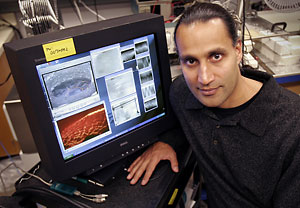UC Berkeley Web Feature
UC Berkeley's MacArthur fellows
Volcanoes on Mars; lava lakes on Io
Michael Manga, associate professor of earth and planetary science
20 September 2005
Michael Manga seems to have gotten stuck on those high-school volcano experiments. Instead of using baking soda and vinegar, however, he uses corn syrup and oil to simulate the viscous processes operating inside the Earth and inside numerous planets and moons, from Mars to Jupiter's satellite Io.
 Michael Manga (MacArthur Foundation photo) |
With a mix of salad oil and motor oil, for example, Manga tested theories of how hot rock in the Earth's interior rises to the surface and creates volcanic hot spots. Another experiment involves a large tank holding nearly 2 tons of corn syrup, which he uses to simulate the roiling mantle and its interaction with the constantly moving crust.
Manga also is investigating springs that seem to ebb and flow with earthquakes and volcanic eruptions, including springs along the Hayward Fault. And he just got back from the Australian interior, where he was looking at desert springs that produce surface features similar to those photographed on the surface of Mars.
"What's interesting about some of the springs in Australia is that they create landforms that may be similar to volcanoes," he said. "Water is coming up, it's depositing material and creating little hills."
His most recent simulations have been of lava lakes, the cooling surfaces of which crack in geometric patterns like those seen on Io. Using heated wax cooled at the top, he and an undergraduate student are studying the zigzag patterns on the surface and what they tell about the molten movements underneath.
"One of the long-term applications of this is looking at Io, the closest moon to Jupiter," he said. "It has huge lava lakes on it. We anticipate eventually getting very high resolution images of the lakes, and it would be nice to figure out what you can learn from those images."
Manga is a native of Ottawa, Canada, who received his undergraduate degree from McGill University in 1990 and his Ph.D. from Harvard University in 1994. After a Miller Post-doctoral Fellowship at UC Berkeley, he moved to the University of Oregon in 1996, where he was on the faculty for five years until moving to UC Berkeley permanently in 2001.
He lives in Berkeley with his wife, Bancroft Library archivist Susan Storch, and their two young boys, Max and Mo.
Related link:
- Michael Manga's home page
- What makes volcanoes explode? It's the bubbles
- UC Berkeley geophysicists report experimental evidence supporting theory of mantle plume and hot spot stability

